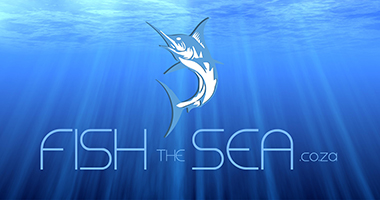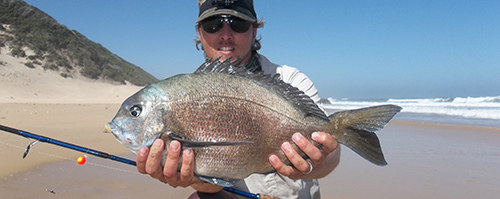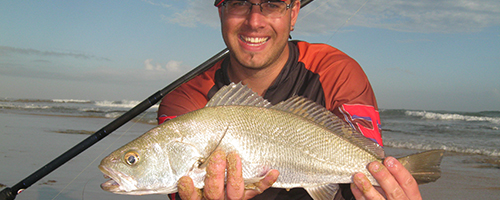The Berg-Breede River Whitefish (The Cape Whitefish)
The Cape Whitefish or Berg-breede River Whitefish (Barbus andrewi) is a ray-finned fish species in the family Cyprinidae. It is placed in the "wastebin genus" Barbus - the typical barbels and relatives - by default. But actually it is far less closely related to the typical barbels than to the South African redfins in Pseudobarbus, and may well belong in the latter genus. Like Pseudobarbus but unlike most other African "barbs", it is tetraploid. Its closest living relative is probably the Sawfin.
Distribution and ecology
It is endemic to the Western Cape Province of South Africa, where it occurs in the Breede River's Brandvlei Dam and Sanddrift Dam, as well as the Heks River. Formerly, it was also found in and around the Berg River, but it seems to have disappeared from there. Populations have also been transplanted to farm water catchments, but it is not well known if these have thrived or failed.
It inhabits the deeper stretches of rivers with rocky shores or riparian trees. While young fish are common in riffles, adults are not rheophilic and will thrive in slow-moving water. Young fish are carnivores, eating zooplankton and small aquatic invertebrates. Adults have a more omnivorous diet that consist of benthic invertebrates and algae. The breeding season is in late spring (about October) when the water has warmed to above 20 °C (68 °F). Schools of adults form to migrate to riffles with over 1 meter/yard deep water and spawn in the late hours of morning. A good-sized adult female produces about 100,000 eggs. In dams, it will use rocky and gravelly substrate in the shallows as a spawning place. The species is long-lived.
Status and conservation
This species is considered Endangered by the IUCN as it has declined much in recent decades. The main threat is the introduced Smallmouth Bass (Micropterus dolomieu), which has killed off the stocks of B. andrewi in the Berg River watershed by eating juveniles. In Brandvlei Dam, where the barb's population is most healthy, the African Catfish (Clarias gariepinus) is spreading; its impact on B. andrewi will need to be assessed. The Common Carp (Cyprinus carpio) and Mozambique Tilapia (Oreochromis mossambicus), introduced for aquaculture, are competing with the Cape Whitefish for food. Water pollution is also a problem.
It is also listed as Endangered by the Nature Conservation Ordinance of Western Cape Province. For the time being, it may not be killed and only caught for supervised transfer trials to other habitat. There is an initiative aimed at restoring the stocks, so that this large fish can be used in fishing and maybe aquaculture as an alternative to the harmful introduced species.
Endangered status
Most the major decline happened in the mid-20th century because of the introduction of alien fishes, mainly smallmouth bass. Current decline is occurring at a much slower rate than previously experienced. Therefore criterion A does not apply. Actual area of occupancy (AOO) has been calculated as 189 km² meeting the criterion B2 threshold for Endangered. Apart from occasional unconfirmed reports from some sections of the Breede River system, existing populations are severely fragmented with probably no migration between the major populations that remain. Only three locations remain (Heks River, Brandvlei Dam and Sanddrift Dam). Some introductions have been made into farm dams but there is no evidence yet that the introductions are successful. A dam in Porterville was stocked with this species, but recently bass was introduced stopping recruitment. The only remaining riverine population of this species has been invaded by smallmouth bass recently. The general quality of the riverine habitats is continually declining because of the intensive nature of expanding agricultural activities in the region, which include the use of pesticides, river channelisation and over-abstraction of water. The Brandvlei Dam population has been a stronghold for this species over the years, but is vulnerable to invasion by alien fishes. There are already unconfirmed reports of sharptooth catfish (Clarias gariepinus) in the dam. Brandvlei Dam is known to have a substantial viable population and Sanddrif Dam is suspected to also have many recruiting individuals. The riverine populations, however, have very low numbers of adult fish (probably less than 1,000) and are probably decreasing due to further invasion by smallmouth bass. This loss, however, only affects a small proportion of the overall population therefore criterion C does not apply. Overall population size is expected to be large, therefore criterion D does not apply. No quantitative analysis has been conducted, therefore, criterion E is not applicable. The resulting assessment classifies the species as Endangered under B2a(ii) and B2b(iii,v).
History:
1996 - Vulnerable
1994 - Vulnerable (IUCN)
1990 - Vulnerable (IUCN 1990)
1988 - Vulnerable
***The information of this article was obtained from 2 sources: http://en.wikipedia.org/wiki/Cape_Whitefish & http://www.iucnredlist.org/apps/redlist/details/2560/0 ***








